Forbidden West Review – I Recommend Robot Dinosaurs And Forbidden West – WGB, Home of AWESOME Reviews

Horizon: Zero Dawn was the surprise of 2017, in many ways. It’s not like people weren’t excited about the prospect of a new game from the developers of the Killzone franchise, but a new IP is always risky and Guerilla was taking a sizable step out of their comfort zone, going from a first-person shooter to a third-person action-adventure set in a massive open world. Any doubts were quickly smashed into pieces though, as Forbidden west sold over 2.5.-million copies in just the first two weeks, and as I write this that number is now over 20-million. Clearly, Sony had a new franchise on its hands and a sequel was all but inevitable, especially as Guerilla had carefully laid the foundations for Aloy’s next adventure. Half a decade later that sequel has finally arrived, and while it’s not a true PS5 exclusive, Horizon: Forbidden West is a safe, solid follow-up that will doubtless sell millions more copies before the series disappears for another 5-years.
The opening hour is a little rough, though, seemingly because Guerilla were afraid that a lot of new players were going to jump into Forbidden West without any knowledge of the first game. The initial 60+ minutes are given over to recapping the foundations that were laid in Zero Dawn, which in fairness I appreciate because my memory tends to suck, even when it comes to games I recently completed. Still, even with this time being used, anybody coming into Horizon for the first time faces a daunting amount of crazy names and concepts being thrown at them. This, after all, is a post-apocalyptic game where tribal people live alongside hulking machines that wander the landscape. You can absolutely muddle through, but I’d highly recommend checking out a video recapping all the major points so that you don’t feel too lost when words like Zeniths, Zero Dawn, and Focus get thrown around.
Available On: Playstation
Reviewed On: PS5
Developed By: Guerilla Games
Published By: Sony
Forbidden West is a fairly direct sequel, picking up mere months after the end of Zero Dawn. Aloy is now on a mission to save the world, and standing in the way is the mysterious Zeniths. So Aloy has to journey far into the “forbidden” west (which isn’t actually forbidden) to track down what she needs in order to reboot Giaa and recover all of its various sub-functions. Overall, there’s a bigger scoop of sci-fi dropped onto the story and generally stronger writing that doesn’t tend to rely so heavily on leaden lumps of exposition, rather spacing out the mumbo-jumbo throughout the 30-70 hours it can take to wrap Forbidden West up. Other things make for a more enjoyable story, too, like a more cinematic flair that brings the cutscenes to life, and plenty of movement during dialogue sequences to help keep you invested. Whereas in Zero Dawn it was often two heads speaking to each other, characters will now get up from a bench and walk around as they speak or gesticulate madly. Meanwhile, their impressive facial animations and truly excellent voice acting are some of the best in the business.
Aloy has gone through a couple of changes between games, both for the better and for the worse. She’s far more confident now and has lost the naivety she initially had. She has taken on the weight of the world and has extensive knowledge of the technology scattered around the land that other people still view as godly and mysterious. And, of course, she’s a hero now, a living legend and even the farthest tribes seem to know of the red-haired warrior and defer to her. She’s basically Jesus, at this point, and any hint of her having to come to terms with everyone’s near-worship is quickly brushed aside. Considering Aloy doesn’t tend to enjoy the attention, it’s slightly odd that the writers don’t opt to do more with her having to deal with everyone’s adulation.
She’s also regressed, too. The first game was the story of Aloy the outcast learning to trust again and to make friends who loved and respected her. It formed a solid emotional core, but for the sequel, Guerilla has gone backwards. At the very start of the game, Aloy has abandoned her friends and set out on her own yet again, leaving her comrades to chase after her and try to convince her that she can’t do this on her own. It’s retreading ground we’ve already covered, and the result is that Aloy doesn’t really have a personal journey this time. The Aloy in the opening hour is the same Aloy when the credits roll.

There’s also an issue with her personality. This incarnation of Aloy is armed with vastly superior knowledge compared to almost everyone she encounters along with an obsessive need to complete the mission, which is understandable given the nature of it. But this means she comes across as abrupt and rude quite frequently, shoving her way through conversations. She doesn’t have time for anybody, except when they are offering a side-quest, in which case the fate of the world can go shove itself up a robot dinosaur’s arse.
And then there’s the fact that I just don’t like Aloy very much. I’m aware I’m very much in the minority here since there are countless pieces of fan art depicting Aloy kicking butt, but for me, she has the personality of a damp cardboard box. She’s dull, and without the emotional journey of learning to trust again, she has little in the way of interesting traits. She’s a monotone protagonist, somehow showing less personality that the very woman she is a clone of. The only thing that makes Aloy a passable protagonist is Ashley Birch’s breathy performance, the actor once again giving it her all. There’s no shortage of dialogue, either; on top of all the main story stuff, there are hours upon hours of voiced side-quests, plus deeper dialogue trees that you can opt to explore. I shouldn’t just credit Birch either, because the acting is absolutely top-notch across the board, perhaps even beating out Guardians of the Galaxy, albeit not in terms of character writing.
Aloy gets outshone by her friends and allies constantly. Varl and Erend are back with Varl, in particular, playing a big role in events, and they get joined by a bunch of new faces. There’s the gruff one-armed warrior known as Kotello, for example, and Alva who gets positively giddy about data. There’s an almost Mass Effect structure to the game as you gather up companions before the big finale. For the most part, they chill out at your base, meaning if you really want to get to know them you need to head back between story beats and explore their new dialogue options. They’re a fascinating bunch, and I only wish they could have gotten individual moments to shine and more emphasis on the group dynamic, rather than just their one-on-one interactions with Aloy. More than anything, I wish they could be taken along on missions more often so their personalities could be explored further because the incredible voice actors deserve more meat to tear into.
Plus, being able to take companions along could stop Aloy from talking to herself all. The. Godamn. Time. I praised another Sony exclusive game for having a talkative lead character, but in the case of Days Gone Deacon’s constant rambling served almost entirely to reinforce his character. He was talking to himself, muttering and cursing like a real human stuck in a horrible situation might do. Aloy, however, is very clearly talking to the player, frequently repeating the same lines or even spoiling the solution to a puzzle before you’ve even started working on the damn thing. After 60+ it’s fair to say that I would nail my own lips to a cat’s arse than listen to Aloy tell me that medicinal berries are handy for the billionth time. Yes, Aloy, I am aware. And I also know they’ll magically go to my stash if my pouch is full. And yes, I already figured that I need to leap directly backwards off of the wall. WOULD YOU PLEASE SHUT UP!?
As fun as the story and its unpredictable twists and turns are, the ending is what may cause some division. Firstly, and without spoiling anything, the ending might be a little too much for some people as it charges headlong into Horizon’s sci-fi elements. And secondly, and again without spoiling anything, the finale sets up heavily for a third game and in the process of doing that doesn’t wrap this story up in any particularly satisfying way. It’s actually annoying how often I’ve voiced this sentiment lately; laying the groundwork for a sequel is fine, but that should not come at the expense of writing a solid ending for the existing game. In short, the journey is fun, the destination is just okay.
There are a lot of changes to how Aloy can get around the vast world, starting with her mountaineering skills. No longer are you constrained to very specific patches that can be climbed, now you can clamber up loads of things. A press of the stick sends out a pulse that lights up rockfaces like a freaking Christmas tree, dozens of little neon lines indicating handholds for Aloy to use and abuse It’s still far from perfect because Aloy has a habit of randomly stopping, forcing you to shuffle around until she decides to finally jump to the next handhold, but it’s a huge improvement over the first game and opens up some fun new approaches to taking on enemies. And once you reach those high points you can glide back down using the new Shieldcaster. It’s surprising how little that new tool gets to shine, though. It actually makes me think it was maybe added later in development as a faster way to get down from higher locations. Regardless, climbing has been improved and while that doesn’t make it more fun it does make it smoother.
It isn’t just new heights Aloy can reach, either – now she can reach new depths! Literally, not morally. Obvious. Aloy is a good girl. The point is she can swim now, and even manages to acquire a handy device that allows her to breath indefinitely under the waves. There are entire underwater missions that let you explore sunken cities and laboratories. Since bows don’t work well in water,r stealth is the only option when huge machines are lurking nearby, so handy patches of I kid you not, Stealth Kelp can be used to hide in. The controls can be a little wonky, but overall being able to explore the depths is a fun addition to the formula. Just don’t think too much about how Aloy learned to swim so well between games.
The open world is massive and very predictable in its structure, ticking every single box in the Big List of Open-World Stuff list. There are rebel outposts to conquer, icons litter the map teasing relics to be found and Tall Necks to climb, and side-missions are found at the numerous outposts and cities. To put it simply, Forbidden West plays it incredibly safe with its open world, which means you know exactly what to expect of it and it delivers on that promise. Really, it’s just a shame that Guerilla happened to launch their big sequel around the same time that Elden Ring hit, a game getting huge praise for how it handles its open-world. It’s not the first time, either – Zero Dawn came out at almost the same time as Breath of the Wild, another game praised for its groundbreaking world.
Aloy’s playground is absolutely gorgeous, rich in vibrant foliage and costumes that practically sing if you have a HDR-capable TV. The myriad of machine animals that lumber around is some of the coolest designs I’ve ever seen and are packed with a stunning level of detail that can only really be admired by using the photo mode. In the middle of the intense action it’s hard to get a good look at the various pieces of armour adorning a giant mechanic T-rex that’s busy launching missiles at you. And let’s just take a moment to appreciate that: a robot T-Rex that fires missiles. But that isn’t the best of the machines because that award easily goes to a newcomer; the monstrous Slitherfang, a humungous metal cobra that wraps around the scenery and is a joy to fight. In other places, the level of detail is just as absurd, like the moss on the ground or the flowers or the subtle texture work in a character’s costume. It’s a huge upgrade from Horizon: Zero Dawn. However, in fairness, I’ve been playing the PS5 version of Forbidden West, an upgraded version of the core game offered for free by Sony after they attempted to charge people $10 for the privilege despite previously saying they wouldn’t. But don’t panic – I’ve checked out the PS4 version, too, and it’s still beautiful.
Following the trend, Forbidden West has a couple of different performance modes to pick from. It defaults to favouring 60fps at the cost of some graphical bells and whistles, and I personally think it’s the right mode to go with. It doesn’t quite manage to maintain a locked 60fps but it’s close and the smoothness provided by the higher framerate makes the already excellent combat even better. Of course, it’s still worth switching over to the fidelity-focused mode to soak up the native 4k imagery. The 1800p checkerboard of the performance mode takes away a lot of fine detail and can even create a slight blur on a 4k screen, while the true 4k picture reveals every little nuance. In particular, running in 4k 30fps makes the vistas much more impressive.
Of course, the world isn’t only inhabited by angry machines, there are plenty of humans to encounter in the west, and again Forbidden West impresses. The different tribes are fascinating, like how the Utaru carry around little seed pouches for their entire lives and when they die those seeds are planted. The costume design is excellent, and I just wish the game would let us spend more time learning about the tribes and their ways because their surface-level traits are so interesting.
But let’s go back to those machines because obviously, the giant, metallic monsters are the reason you play Horizon, the reason your inner child is screaming its lungs out in your head. Years ago in a shoddy Binary Domain review, I said that dismantling robotic opponents wasn’t as satisfying as battling humans. I would like to rescind that statement and deliver a time-travelling dick-punch to my past self for being so damn dumb because waging war against Horizon’s menagerie of machinery is absolutely fantastic. Aloy controls better than ever and the foes you battle are a joy, all of them aggressive, deadly and packing a variety of attacks and tricks. Combat is intense and can often last several minutes as you slowly bring down a multi-ton behemoth while also ripping off valuable components you need to upgrade your gear. Although there is an option to turn off the component system in case you can’t be bothered carefully stripping coils, horns, containers and other stuff off of the machines.
Armed with just a bow the goal is to rip off the outer armour to reveal those vital innards because otherwise, you’re just firing sticks at an armoured dinosaur. Sure, you’ll win via attrition but to be a master hunter you need to be precise. Swap over to some armour destroying arrows and focus on specific panels, target the exposed components that are nothing more than videogame weak points, but while that would normally be a little laughable, in a game with machines weak points make complete sense.
Aiding your goals is a vast array of weapons and elemental damage types, from bows that fire acid arrows to chunky metal spikes that are hurled into armour before exploding. It’s almost a little too much because your weapon wheel winds up divided into about a billion segments for different weapons and ammo types, and you can wind up swapping between them a lot in a fight. Once you get to grips with everything and remember exactly where those bloody Purgewater arrows are, though, it’s fun to match elemental damage to a machine’s weakness or detonate a Slitherfang’s acid containers.
On top of that, you have traps that you can lay down and environmental hazards to utilize. Hunting some of the biggest, baddest machines, which you’ll need to do in order to upgrade rare armour and weapons, has an almost Monster Hunt vibe to it as you scout the terrain, eat some food, prepare traps and tag the exact components you need to focus on. Turn up the difficulty and these fights can be epic back and forth battles as you chip away at armour or even manage to shoot off a heavy weapon that you can then use yourself.
There are a couple of small issues in combat, mind you. The first is that I hate constantly pausing the game to craft more arrows. Upgrading pouches by murdering tiny animals alleviates this, but even then you need to craft more ammo all the damn time. And it’s hilarious that while your medicine pouch can be magically refilled from your stash, you can’t do the same for arrow crafting materials. The bigger issue, however, is some of the enemies themselves. There are a couple of machine types that have absurdly huge ranged or sweeping attacks which feel unfairly hard to dodge, and a few of them even have leaping attacks that can cover a massive distance. I’m looking at you, Tideripper. That shit ain’t cool.
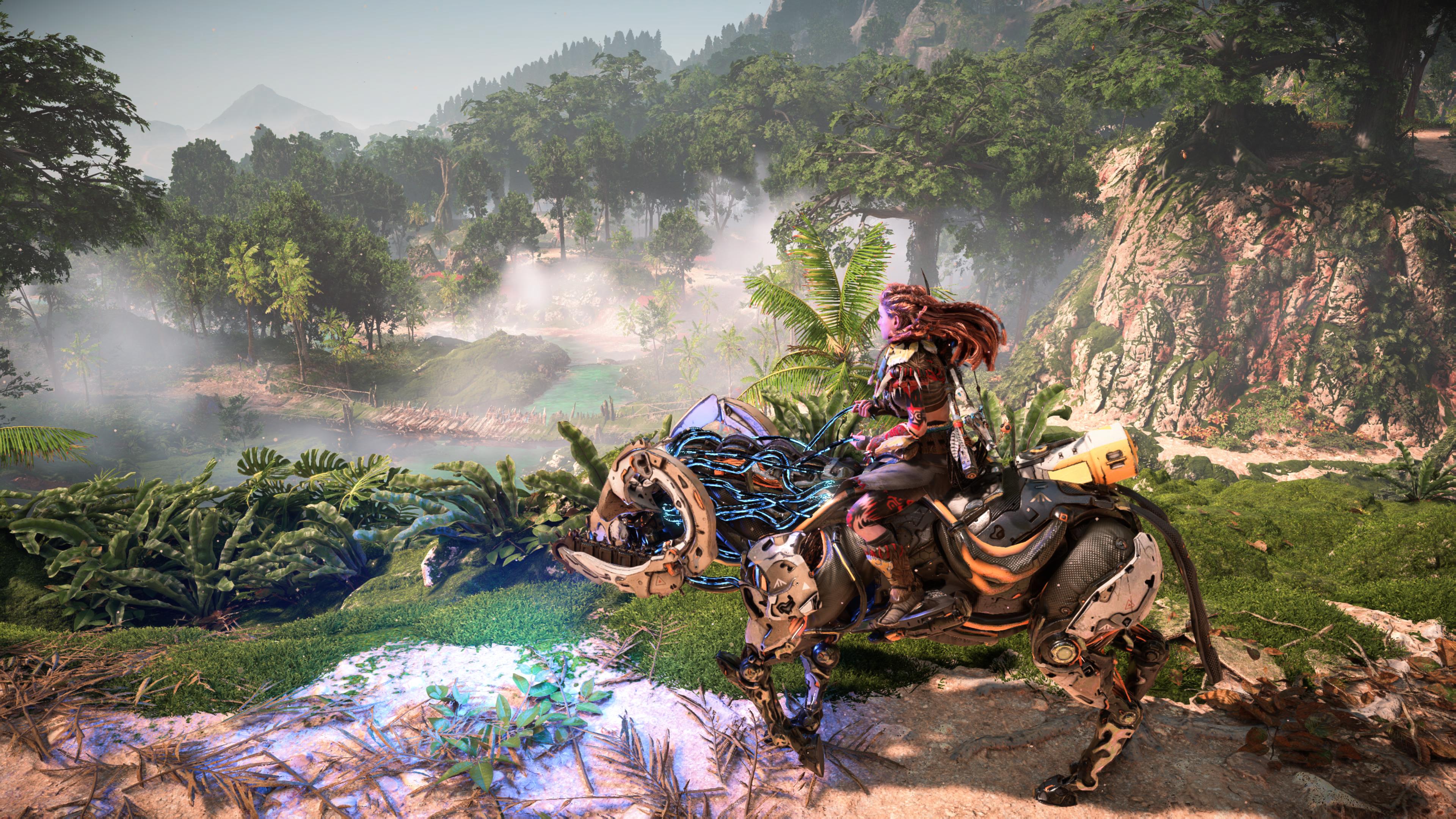
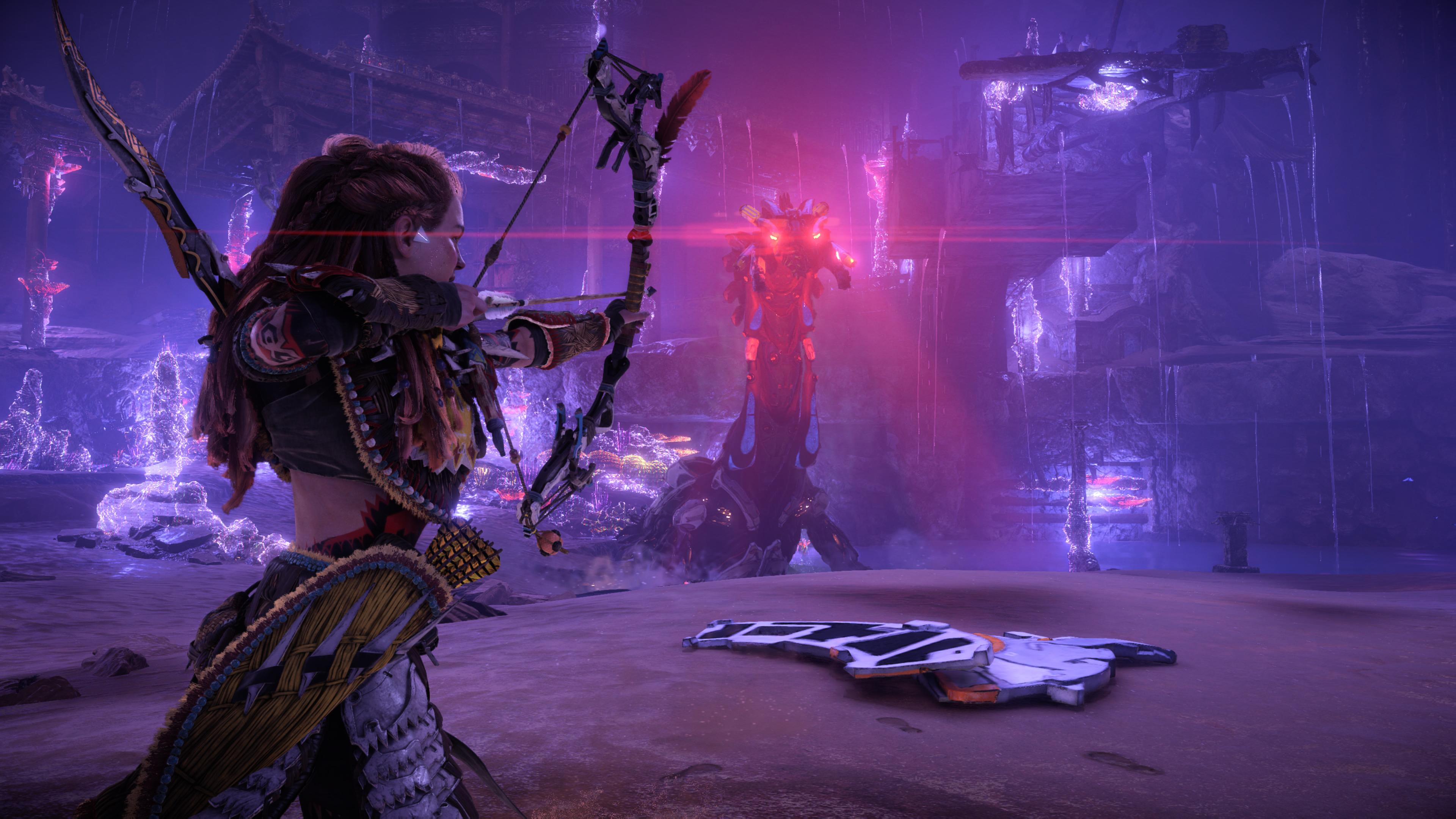
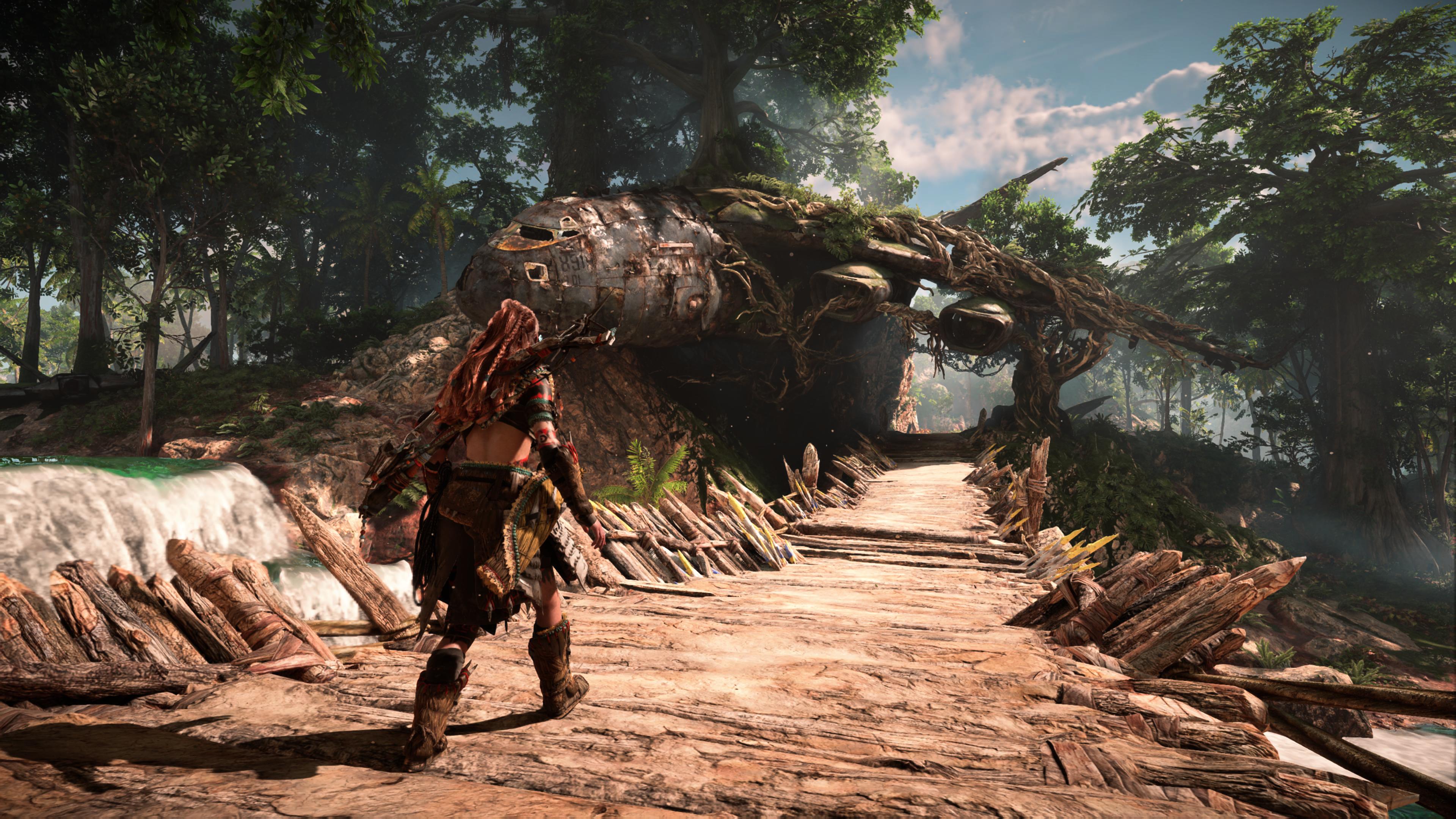
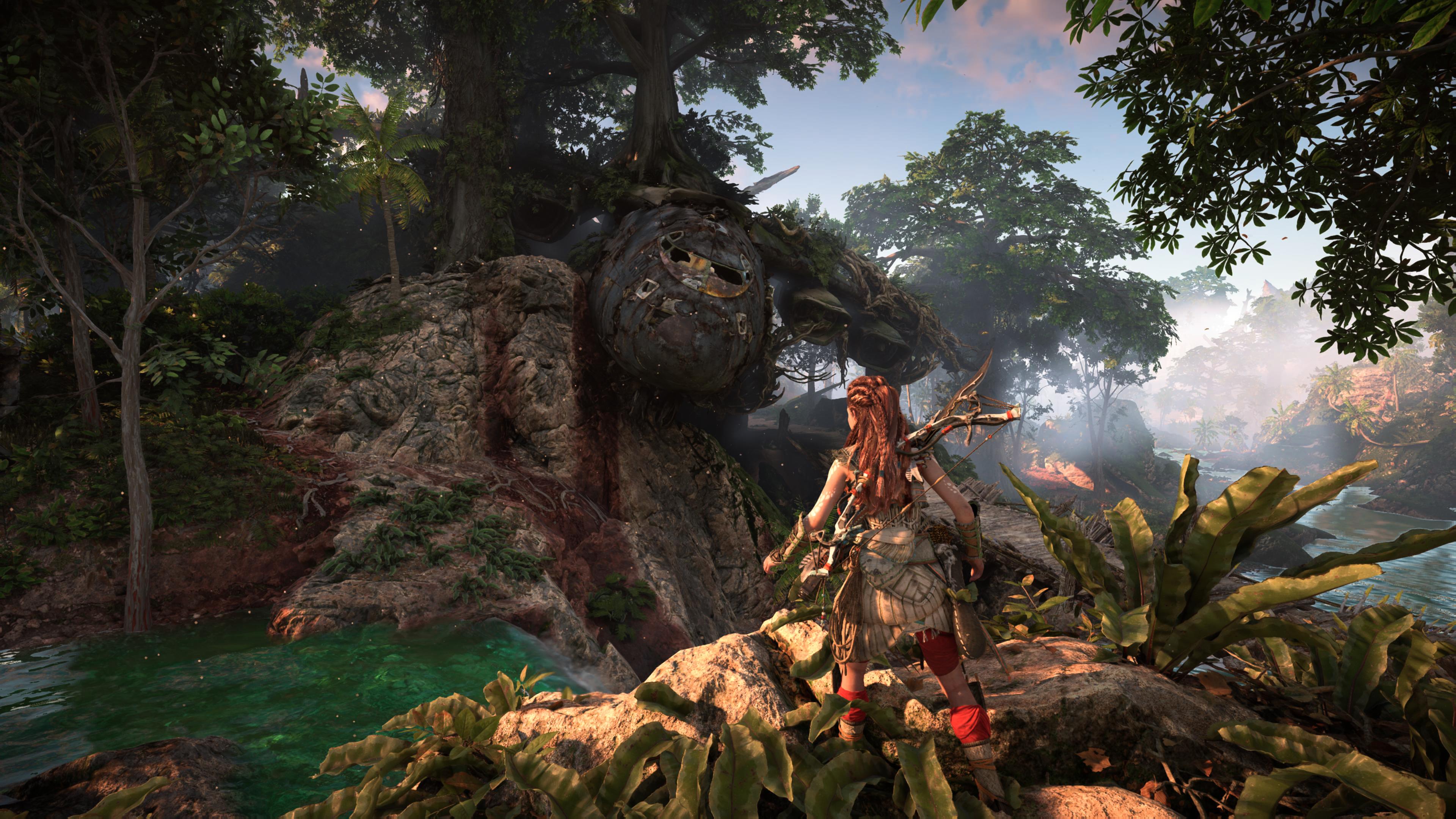
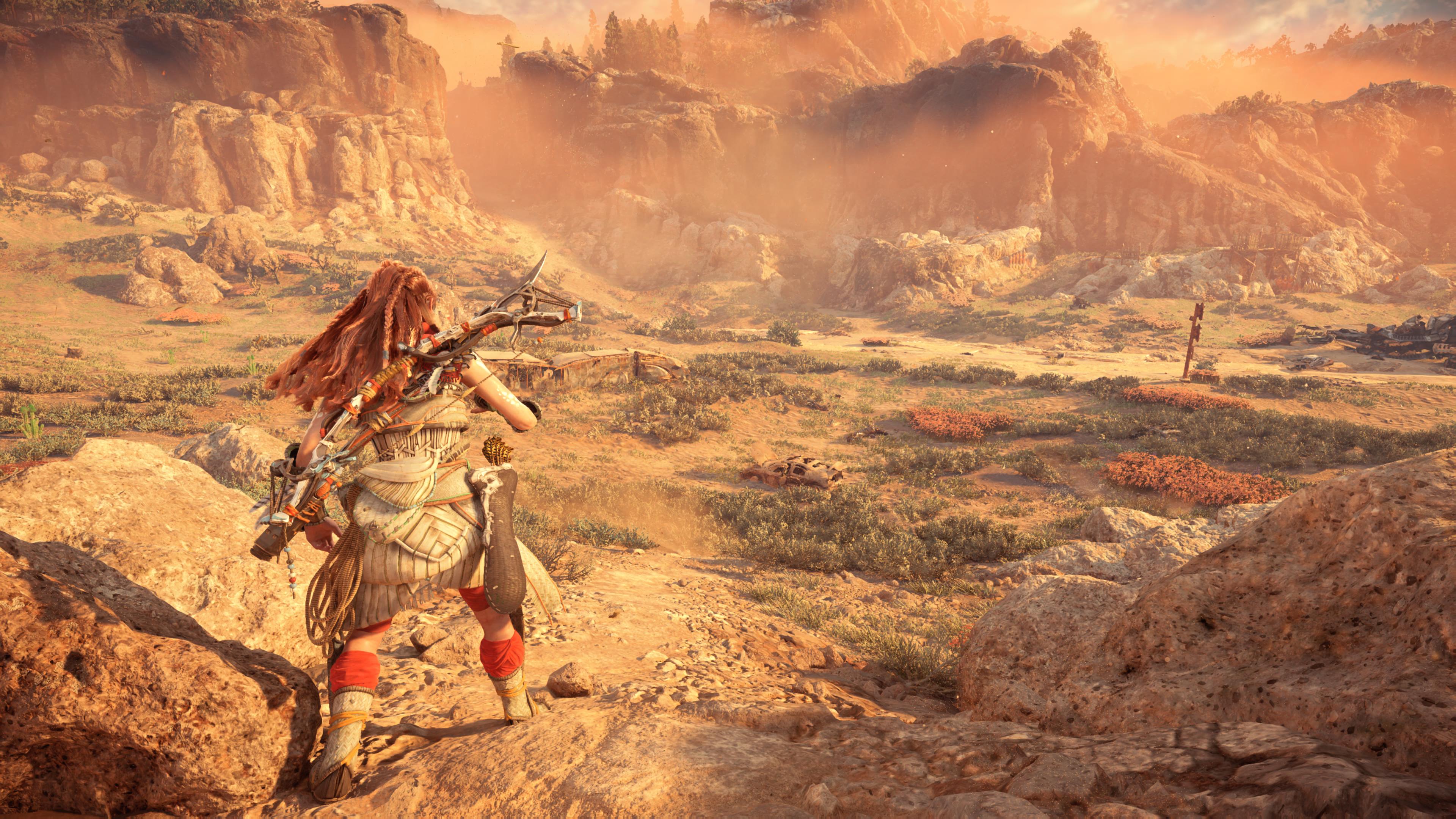
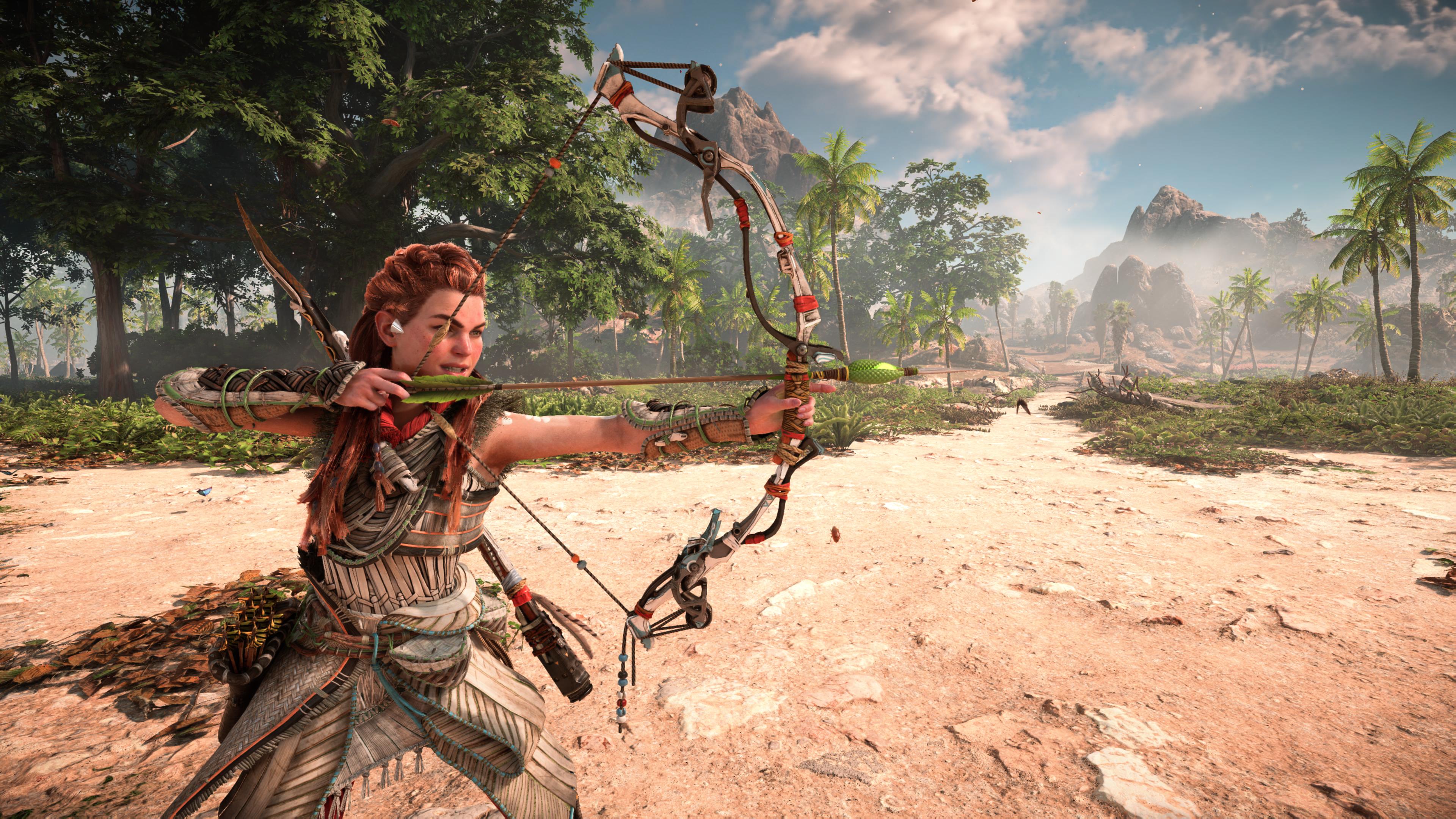
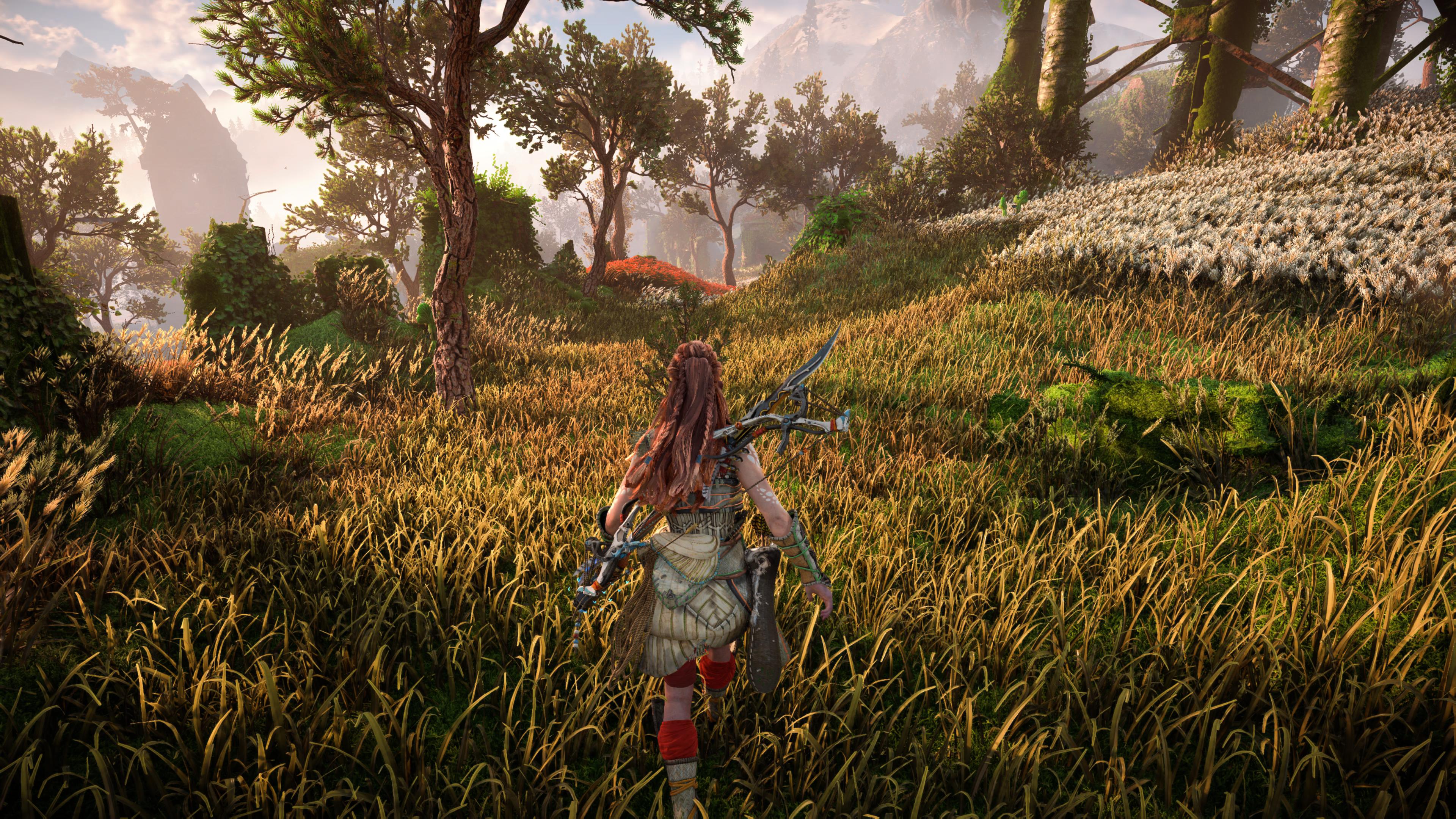
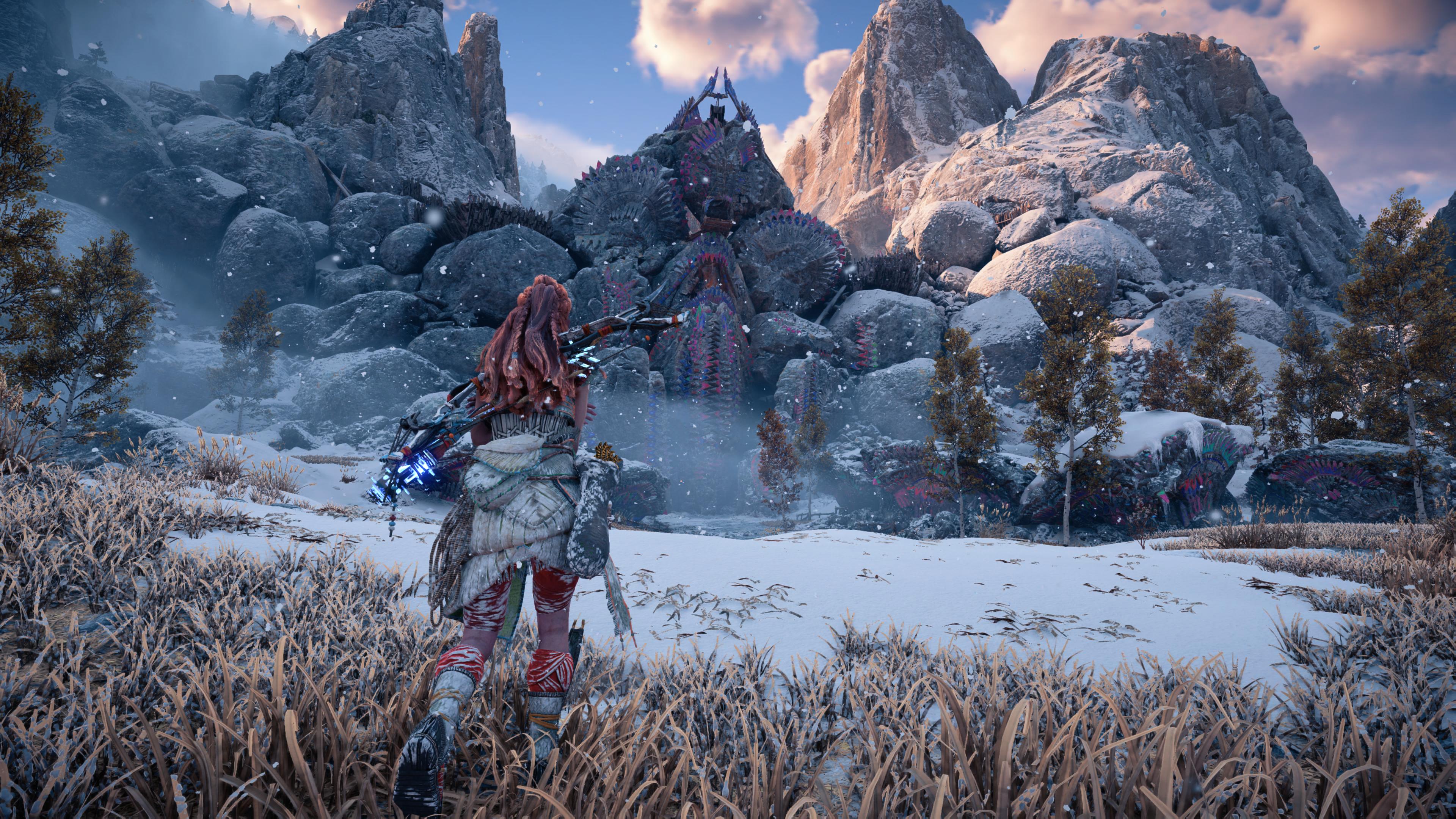
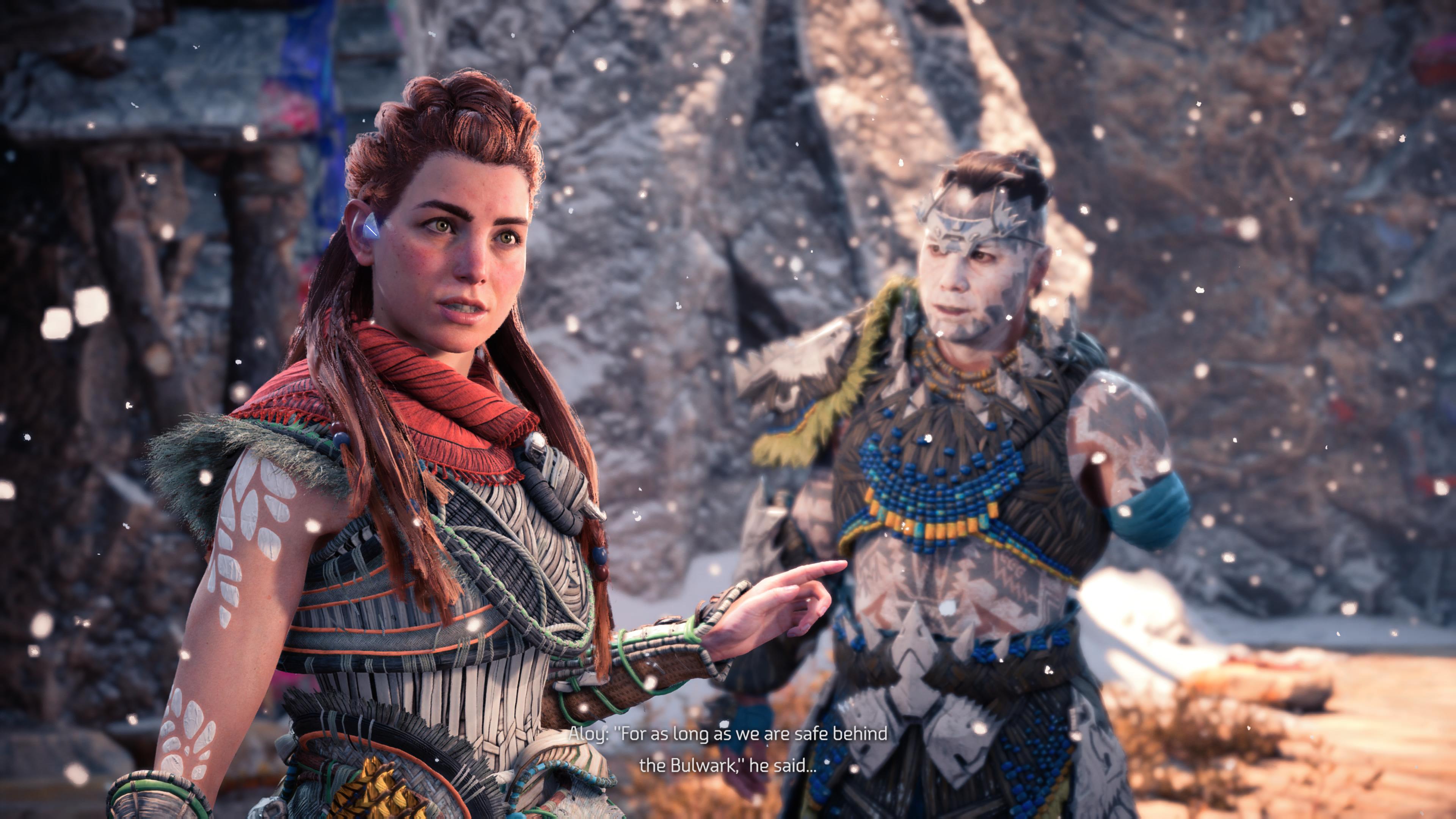
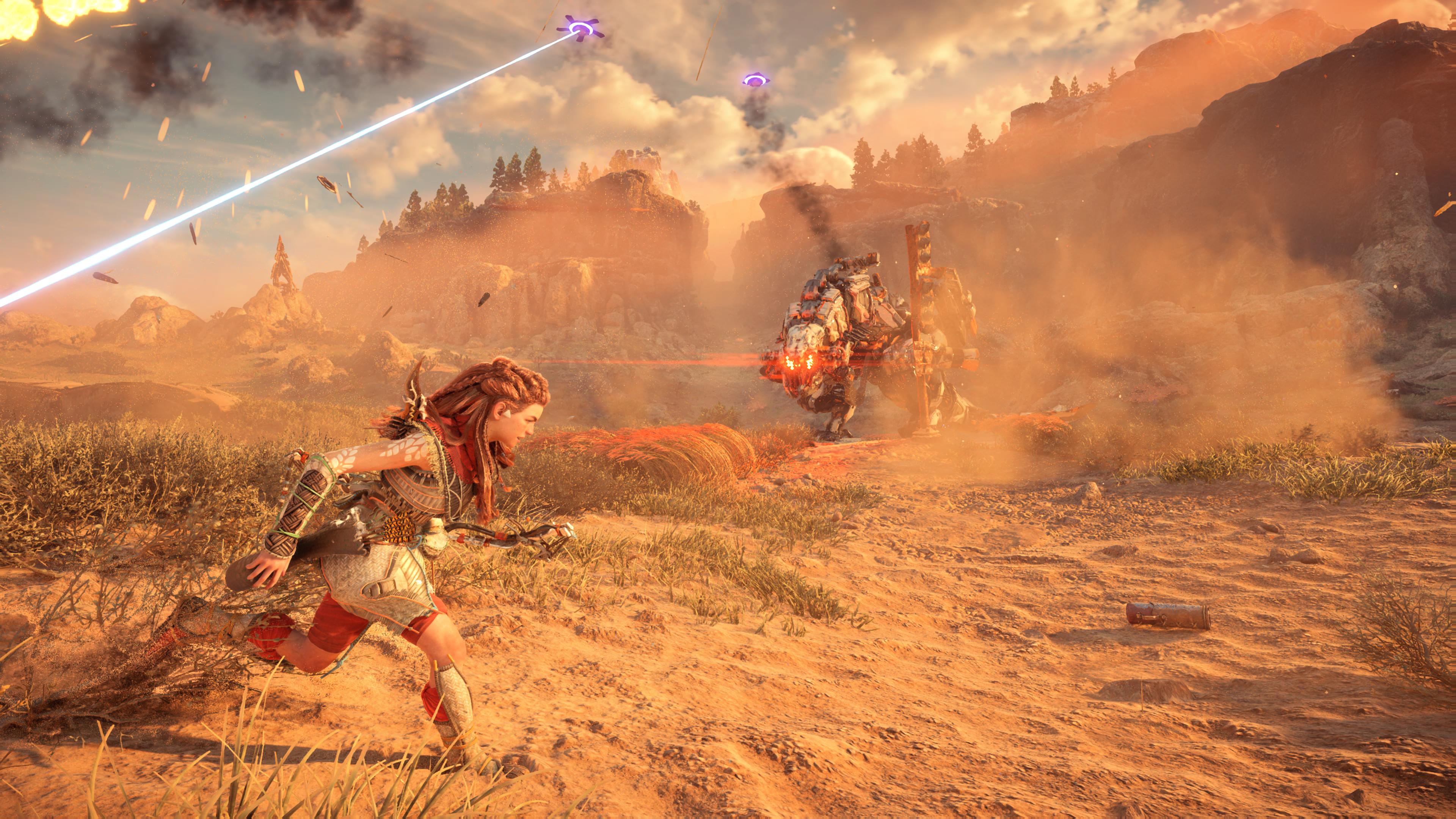
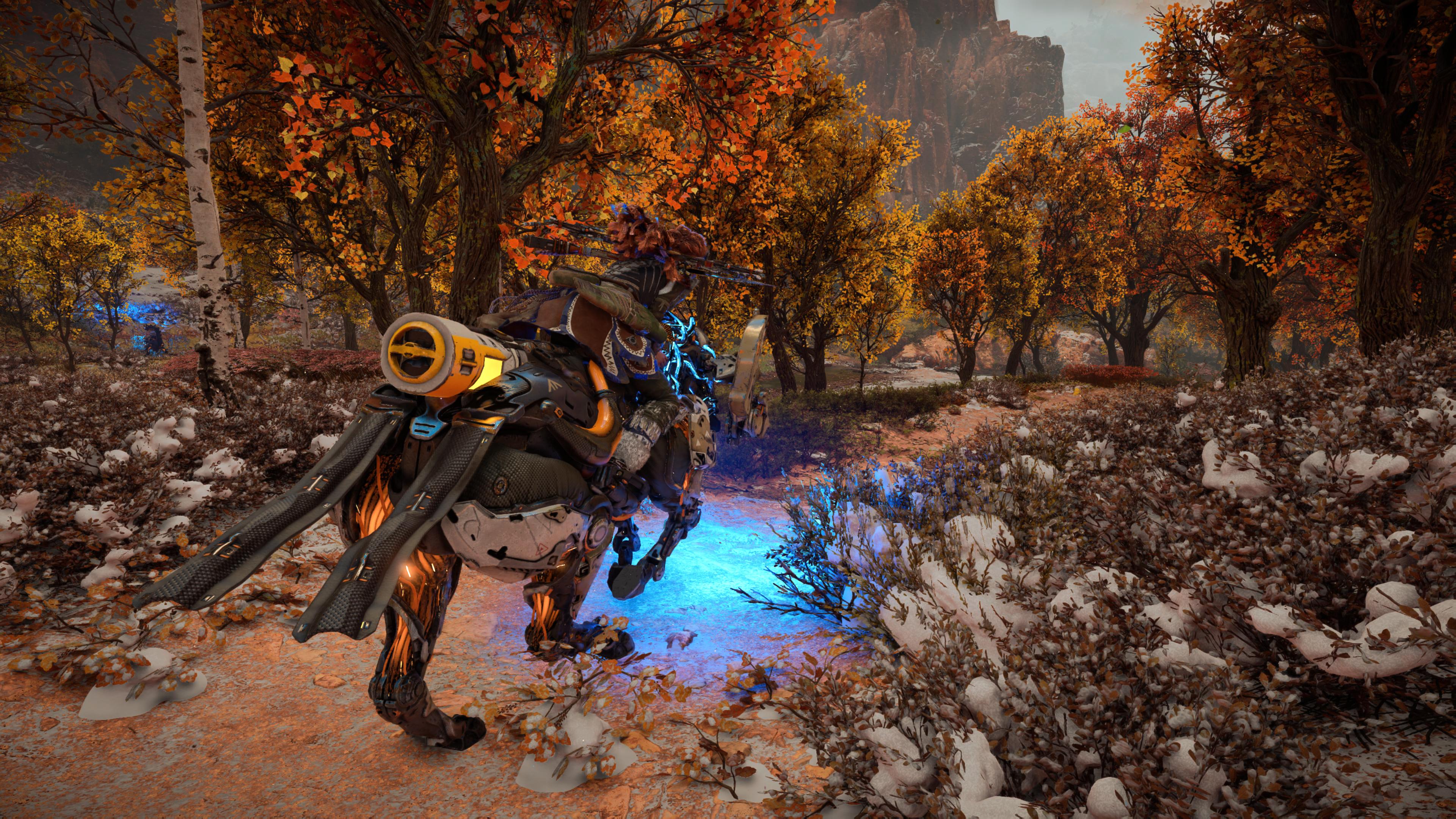
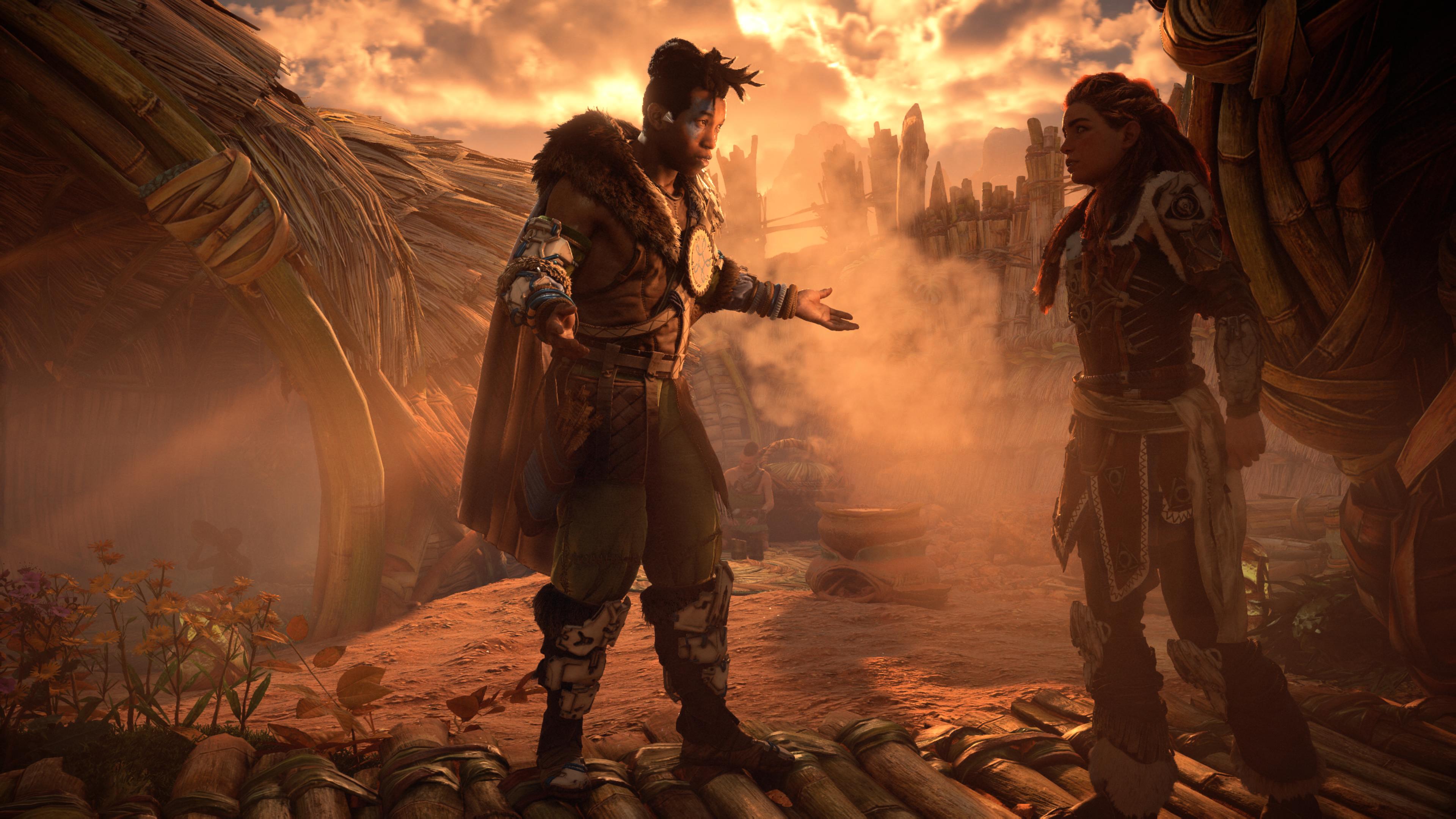
Niggles aside, though, the combat is absolutely excellent. Sure, by the end of the game a couple of the smaller, basic enemy types are more of a chore to fight, but outside of that almost every battle is frantic, fun, tense and dynamic, filled with narrow dodges, perfect shots and a real sense of satisfaction when you take down a big bastard.
While Guerilla has improved many aspects of Forbidden West the stealth remains fairly rudimentary. Hide in patches of red grass and then pop out to deliver sneak attacks that aren’t guaranteed one-hit kills unless you invest some points in the right skill tree. Or you can pop down traps and watch as enemies mindlessly amble around their preset routes (which you can highlight) and get blown sky-high while you snigger. It’s basic, it’s passable but there’s a feeling that the stealth is only there because Guerilla felt it had to be. It becomes laughably bad when enemies are alerted to your presence and begin to “search” for Aloy. They wander around aimlessly or will simply stare intently at the patch of grass they think Aloy is lurking in, without ever actually searching through it. So you crouch in the grass, wait a minute and they forget you exist.
Melee combat has at least got a stronger upgrade and is even a legitimate build thanks to the dedicated skill tree that unlocks combos and abilities. It still feels boring to use, though, and the combat is so clearly built around targeting specific parts of machines, which you can’t do using Aloy’s spear. It’s only really decent when you go up against the much more boring humans.
Wrecking machines, doing errands and completing missions showers you with skill points that can be invested into 6 different skill trees, depending on how your version of Aloy likes to tackle stuff, like more powerful stealth attacks or the ability to carry more traps. Most of the upgrades are standard fare, boosting base stats and making Aloy a better destroyer of machines, but the most interesting ones are special moves for different types of weapons. A Braced Shot for the Longshot dishes out seriously heavy damage, but you could also choose from a couple of different Warrior bow tricks if you’d prefer. The best abilities are the Valors which tend to involve Aloy smearing paint on her face and then getting a big buff or even chugging a health potion like Captain Jack Sparrow chugging a bottle of rum.
There are some issues with the balancing, though. You see, Forbidden West wants you to gorge on its myriad of side-content, from the excellent self-contained stories of the side-missions to the machine hunting grounds and the rebel outposts. It’s one of the few open-world games where I was perfectly happy to venture off and get lost doing nothing but side-content for hours at a time without feeling like it was a list of repetitive chores. However, by doing all the optional stuff before moving on to the next story mission you’ll quickly find yourself comically over-levelled. To be clear, I want and love a sense of growing more powerful than your enemies, but it’s a careful balancing act and one that Forbidden West struggles with. Toward the closing hours, I was nearly hitting the level cap of 50, while the story missions had a recommended level of just 35. The result? Laughably easy fights. The difficulty can be ramped up to counter this, of course, and it’s rewarding to do that because the big machine fights are even better. Still, it’s an awkward solution.
Horizon: Forbidden West delivers exactly what I wanted in most regards; a bigger, better Zero Dawn. Most of the rough edges of the first game have been ground down and then polished to a brilliant sheen. The slick combat is better than ever, some of the most entertaining and downright cool fighting in gaming today. The story is a lot of goofy fun with strong performances. The open world is packed with interesting stuff to do. It’s freaking beautiful. Yes, it’s also a very safe sequel that doesn’t quite nail the ending due to being busy setting up for a third game. It’s certainly not perfect, then. It has flaws, and you could definitely criticize it for being yet another big, third-person, blockbuster game from Sony. But if that sounds good to you, Forbidden West will undoubtedly be in the conversation for the best game of 2022.
Categories: Reviews, Videogame Reviews





